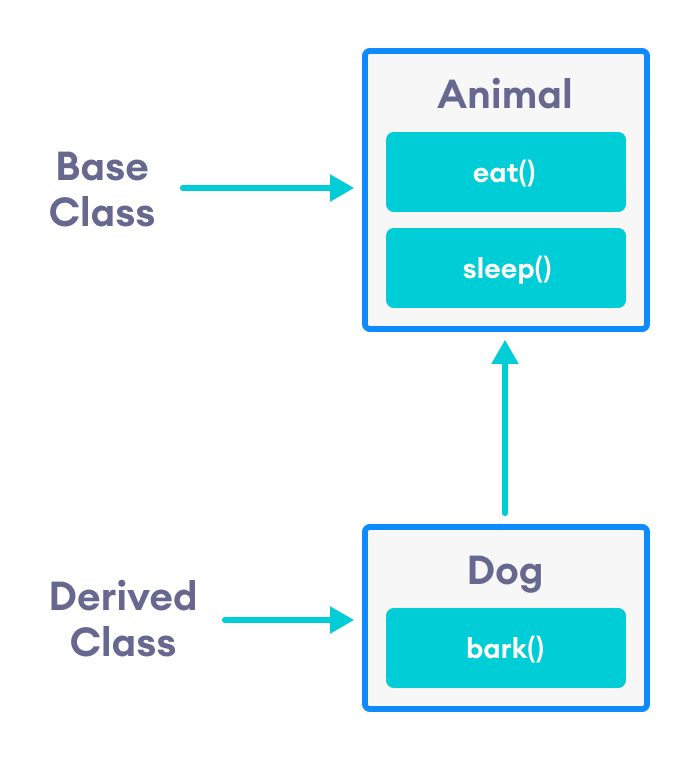📅 最后修改于: 2020-09-25 04:57:55 🧑 作者: Mango
在本教程中,我们将借助示例学习C++中的继承。
继承是C++中面向对象编程的主要功能之一。它允许我们从现有类(基类)创建一个新类(派生类)。
派生类从基类继承要素,并且可以拥有自己的附加要素。例如,
class Animal {
// eat() function
// sleep() function
};
class Dog : public Animal {
// bark() function
};这里, Dog类是从Animal类派生的。由于Dog是源自Animal的成员, Animal是可访问的Dog 。

请注意,从Animal继承Dog时使用了关键字public 。
class Dog : public Animal {...};我们还可以使用关键字private和protected代替public 。在本教程的后面,我们将学习使用private , public和protected之间的区别。
是关系
继承是一种关系 。仅在两个类之间存在is-a关系时才使用继承。
这里有些例子:
示例1:C++继承的简单示例
// C++ program to demonstrate inheritance
#include
using namespace std;
// base class
class Animal {
public:
void eat() {
cout << "I can eat!" << endl;
}
void sleep() {
cout << "I can sleep!" << endl;
}
};
// derived class
class Dog : public Animal {
public:
void bark() {
cout << "I can bark! Woof woof!!" << endl;
}
};
int main() {
// Create object of the Dog class
Dog dog1;
// Calling members of the base class
dog1.eat();
dog1.sleep();
// Calling member of the derived class
dog1.bark();
return 0;
} 输出
I can eat!
I can sleep!
I can bark! Woof woof!!在这里, dog1 (派生类Dog的对象)可以访问基类Animal成员。这是因为Dog继承自Animal 。
// Calling members of the Animal class
dog1.eat();
dog1.sleep();受C++保护的成员
当涉及C++继承时, protected的访问修饰符尤其重要。
与private成员一样, protected成员在课堂之外也无法访问。但是, 派生类和朋友类/函数可以访问它们。
如果我们想隐藏一个类的数据,但仍希望该数据被其派生类继承,则需要protected成员。
要了解有关受保护的更多信息,请参阅我们的C++访问修饰符教程。
示例2:受C++保护的成员
// C++ program to demonstrate protected members
#include
#include
using namespace std;
// base class
class Animal {
private:
string color;
protected:
string type;
public:
void eat() {
cout << "I can eat!" << endl;
}
void sleep() {
cout << "I can sleep!" << endl;
}
void setColor(string clr) {
color = clr;
}
string getColor() {
return color;
}
};
// derived class
class Dog : public Animal {
public:
void setType(string tp) {
type = tp;
}
void displayInfo(string c) {
cout << "I am a " << type << endl;
cout << "My color is " << c << endl;
}
void bark() {
cout << "I can bark! Woof woof!!" << endl;
}
};
int main() {
// Create object of the Dog class
Dog dog1;
// Calling members of the base class
dog1.eat();
dog1.sleep();
dog1.setColor("black");
// Calling member of the derived class
dog1.bark();
dog1.setType("mammal");
// Using getColor() of dog1 as argument
// getColor() returns string data
dog1.displayInfo(dog1.getColor());
return 0;
} 输出
I can eat!
I can sleep!
I can bark! Woof woof!!
I am a mammal
My color is black此处,变量type protected ,因此可以从派生类Dog访问。我们可以通过使用setType() 函数在Dog类中初始化type ,从而看到这一点。
另一方面, private变量color无法在Dog初始化。
class Dog : public Animal {
public:
void setColor(string clr) {
// Error: member "Animal::color" is inaccessible
color = clr;
}
};另外,由于protected关键字隐藏了数据,因此我们无法直接从Dog或Animal类的对象访问type 。
// Error: member "Animal::type" is inaccessible
dog1.type = "mammal";C++继承中的访问模式
在以前的教程中,我们了解了C++访问说明符,例如public,private和protected。
到目前为止,我们已经使用public关键字来从以前存在的基类中继承一个类。但是,我们也可以使用private和protected关键字来继承类。例如,
class Animal {
// code
};
class Dog : private Animal {
// code
};class Cat : protected Animal {
// code
};我们获得类的各种方法称为访问模式 。这些访问模式具有以下效果:
基类的private成员在派生类中始终是private的。
要了解更多信息,请访问我们的C++公共,私有,受保护继承教程。
继承中的成员函数重写
假设基类和派生类的成员函数具有相同的名称和参数。
如果我们创建派生类的对象并尝试访问该成员 函数,则将调用派生类中的成员 函数 ,而不是基类中的成员 函数 。
派生类的成员 函数重写基类的成员 函数 。
了解有关C++中的函数重写的更多信息。
推荐读物: C++多重继承